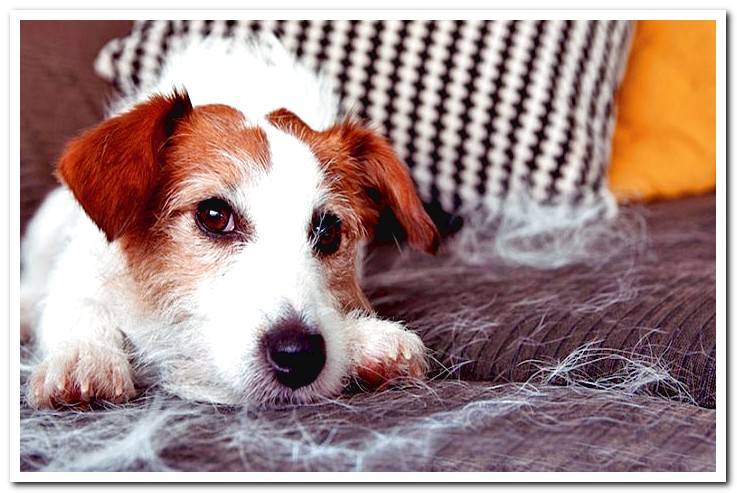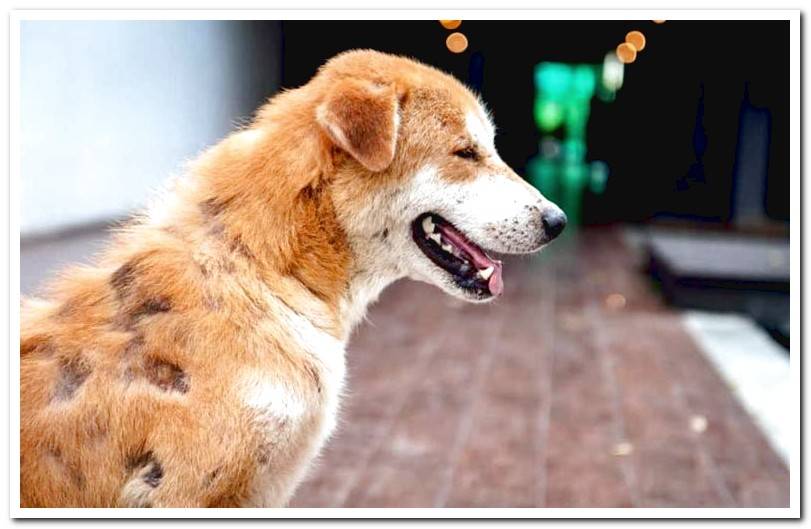
Dogs’ hair falls out regularly a couple of times a year. It is what we know by the name of molt. It corresponds to a normal process of the hair cycle and, therefore, does not pose any health problem.
But sometimes, our dog experiences excessive hair loss, has areas without it or even skin lesions. In these cases, there is a problem that requires diagnosis and treatment. Let’s see what are the most common causes.
Index of contents
- 1 The dog’s hair shedding
- 2 Mistakes in dog care
- 3 External parasitosis
- 4 Skin diseases that cause bald spots
- 5 Other diseases that cause canine alopecia
- 6 Tips to avoid hair loss
The dog’s hair shedding
In general, the molting takes place once or twice a year. It usually coincides with changes in temperature. In Spain this means that we can expect this hair loss before summer and before winter.
All caregivers will identify this period, as they will find large amounts of hair on the floor, beds or your own clothes. It will only be necessary to consult with the veterinaryn if the hair loss is excessive or if we detect any worrying signs such as wounds or bald spots.
Mistakes in dog care
The appearance of the hair is not just a matter of aesthetics. Observing the state of the coat we obtain information about the dog’s health. Hair loss outside the shedding and the appearance of alopecic areas should put us on alert.
First of all we must examine the living conditions of our dog, since we may be making a mistake. Improper diet or stressful situations They are causes of hair loss and, in general, poor appearance of the coat.
Other specific practices, such as collecting the dog’s hair with a lot of tension or for prolonged periods, also cause hair loss in that area. Sometimes these types of bald patches are permanent. If the dog is handled correctly, the hair loss may be due to illness.

External parasitosis
The presence of fleas is a common reason for hair loss, especially in specific areas, such as the end of the back and the beginning of the tail. Sometimes it is possible to detect these parasites, but sometimes we will only see alopecia, wounds or a grit that corresponds to the flea droppings.
In addition, many dogs suffer from what is known as flea bite allergy dermatitis. In them a single sting triggers a picture like the one described, but aggravated. The vet will have to treat these symptoms and schedule regular external deworming, which is the best prevention.
Skin diseases that cause bald spots
In numerous cutaneous diseases it is possible to find injuries and hair loss in more or less wide areas of the body. Before these symptoms, you should go to the vet, since you have to identify the cause of all possible.
The most common are dermatitis, which also occur with itching, inflammation and redness. Also notable are those caused by mites, such as demodectic or sarcoptic mange, or, to a lesser extent, those produced by fungi, such as ringworm. It is very important to treat these pathologies because they are usually very contagious.
Furthermore, they have zoonotic potential, that is, can be transmitted to people. Finally, a more complex type of skin infection that requires prolonged treatment is pyoderma, which presents with itching, considerable wounds, bad odor, in addition to hair loss.
Other diseases that cause canine alopecia
Not all diseases that affect hair are cutaneous. Some pathologies that cause alopecia have a hormonal origin. They are characterized because the hair loss they produce is symmetrical and bilateral.. That is, the hair is missing on both sides of the body.
In addition, the skin seen in the alopecic zone is apparently healthy. There are no injuries or itching. They are diseases like hypothyroidism or the Cushing’s syndrome. They have to be diagnosed and treated by the vet.
Also, there are other diseases, such as allergies, that can lead to hair loss. Its main symptom is itching. It is the intense scratching that the dog starts to alleviate which causes the hair to end up falling out. Allergies should also be treated by the vet. Its resolution can be complex.
Tips to avoid hair loss
Molting, as a natural process, will happen to all dogs to a greater or lesser extent. But we can minimize its effects, as well as avoid, as much as possible, that our dog suffers from pathologies that result in hair loss. Keep these tips in mind:
- Take care of your dog’s coat regularly. Whether it is short or long coat, check it, brush it and wash it according to your needs.
- Avoid using rubber bands or accessories to hold your hair tight or for long periods of time.
- During the molting period, frequent brushing helps to remove dead hair. Everyone that is collected in the brush will not end up on the floor or on clothes.
- Accessories or hair products must be appropriate to their characteristics and always formulated for dogs.
- A quality diet adapted to the life stage of the dog is basic, also for hair health.
- Avoid stress.
- External deworming has to be done regularly.
- Go to the vet if you detect alopecia or skin lesions. Treating early is essential to prevent the condition from worsening. Likewise, any symptom of disease will need the evaluation of this professional.
- After an average age of seven years of age, it is recommended that all dogs undergo a veterinary examination that includes at least one blood test. The objective is to detect pathologies early.
- Of course, if our dog is in treatment for hair loss, we must follow the veterinaryn’s recommendations, which sometimes includes the use of the Elizabethan collar to prevent them from accessing the injuries and making them worse.
